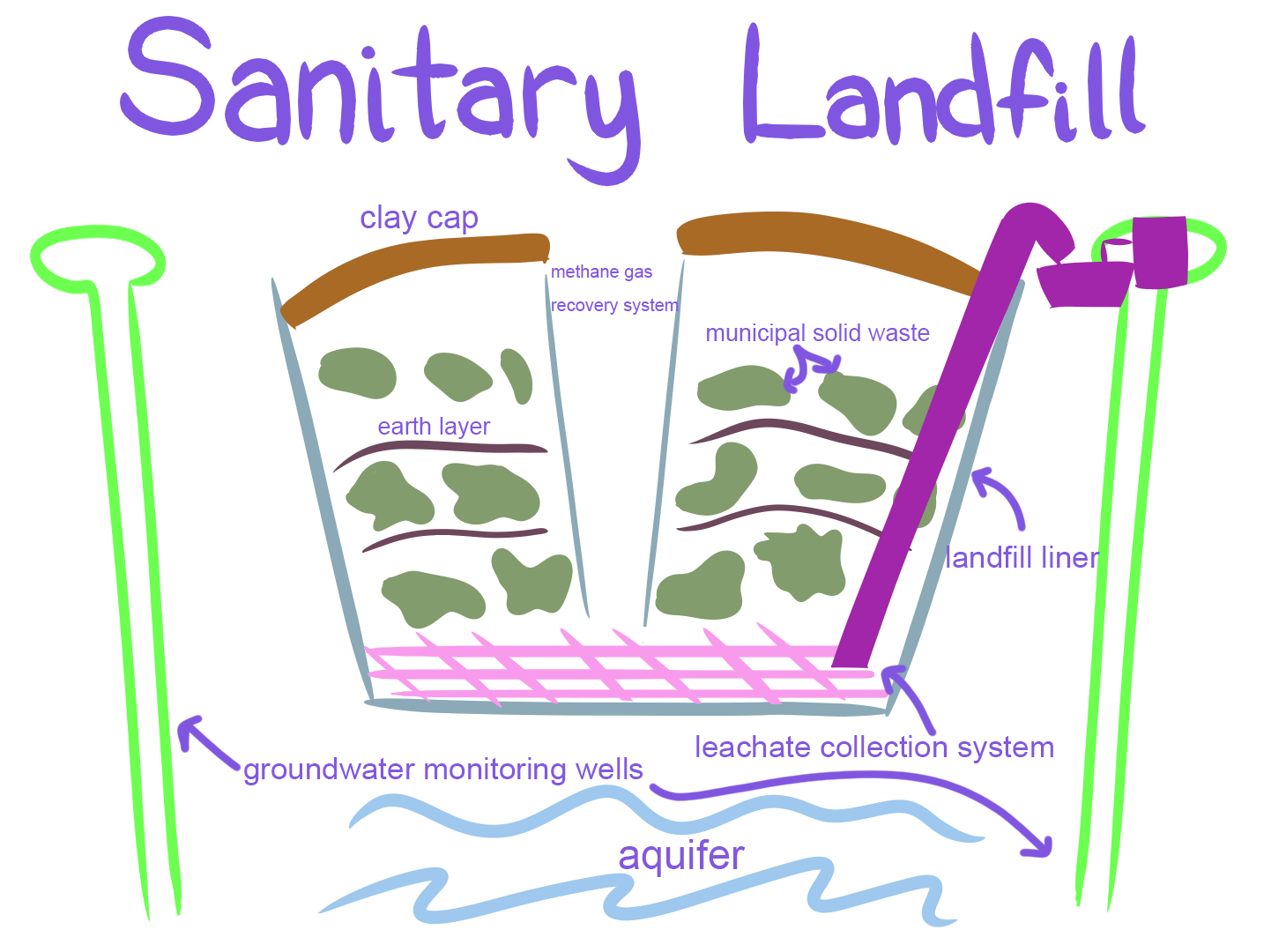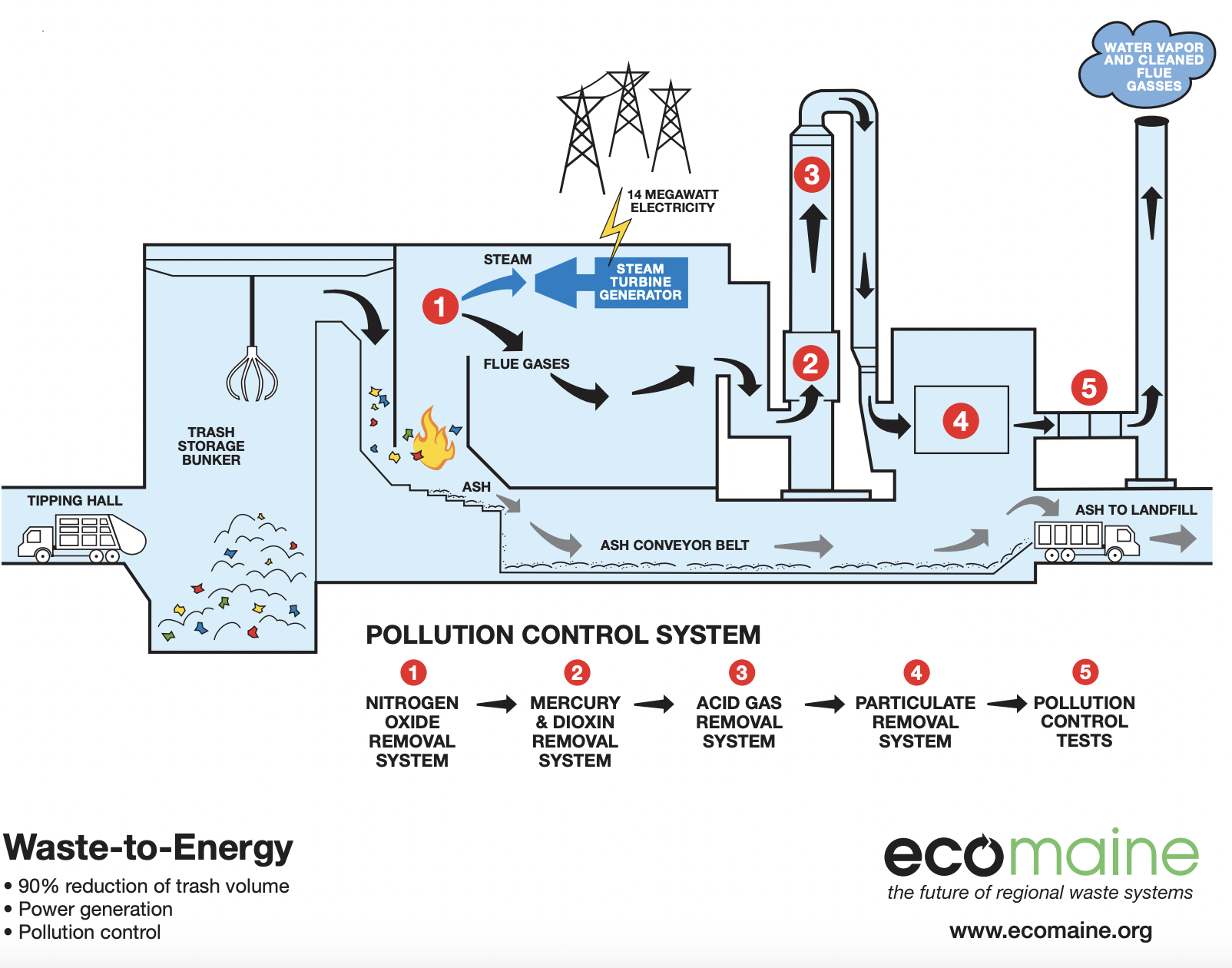IB Syllabus focus:
‘Compare landfill, incineration, waste-to-energy, exporting waste, recycling and composting—each has distinct environmental and societal trade-offs.’
Disposal of solid domestic waste (SDW) is a pressing global challenge. Various methods exist, each with distinct advantages and drawbacks shaped by environmental, economic, and social factors.
Landfill
Description
Landfill is the controlled burial of waste in designated sites, often lined to prevent leakage into soil and water. It remains the most widely used disposal method.

Annotated cross-section of a sanitary landfill showing clay/plastic liners, leachate collection pipes, and methane gas recovery leading to energy use. Labels help visualise how contamination risks are managed and why long-term monitoring is required. Source.
Pros
Relatively low cost compared to other disposal methods.
Can be designed with liners and leachate systems to reduce environmental contamination.
Methane generated can be captured and used as a renewable energy source.
Cons
Produces leachate that can pollute groundwater if containment fails.
Releases methane, a potent greenhouse gas, when not captured.
Requires large areas of land, often displacing communities or ecosystems.
Long-term maintenance is costly due to risks of subsidence and contamination.
Leachate: Liquid that drains from waste, often containing harmful substances capable of polluting soil and water.
Incineration
Description
Incineration involves burning waste at high temperatures, significantly reducing volume and weight.
Pros
Reduces waste volume by up to 90%.
Can generate heat and electricity in combined heat and power (CHP) systems.
Useful for waste that cannot be easily recycled or composted.
Cons
Emits air pollutants such as dioxins and particulates if not properly controlled.
Expensive to construct and maintain.
Ash residue requires safe disposal in landfills.
Waste-to-Energy (WtE)
Description
A specialised form of incineration where energy is recovered efficiently from waste combustion.

Process flow diagram of a municipal waste-to-energy plant, from waste reception through combustion to electricity generation. It highlights sequential flue-gas treatment steps that reduce pollutants before stack release, illustrating why WtE both provides energy and necessitates rigorous controls. Source.
Pros
Provides a renewable-like energy source, contributing to energy security.
Reduces reliance on landfills.
Can offset fossil fuel use for electricity generation.
Cons
High initial infrastructure costs.
Still produces toxic ash and emissions.
Can discourage waste prevention and recycling if over-prioritised.
Exporting Waste
Description
Exporting involves transporting waste, often from high-income countries, to lower-income nations for treatment or disposal.

E-waste workers burn insulated cables to extract copper at Agbogbloshie, Accra—an example of how exported waste can shift pollution and health risks to vulnerable communities. The image adds real-world context to the societal trade-offs of exporting waste. Source.
Pros
Reduces pressure on domestic waste management systems.
Can generate income for receiving countries.
Cons
Raises environmental justice issues, as poorer nations bear the risks.
Transport contributes to carbon emissions.
Often results in unsafe and informal handling, causing pollution and health hazards.
Environmental justice: The fair distribution of environmental benefits and burdens across all social groups and communities.
Recycling
Description
Recycling converts waste materials into new products, conserving resources and reducing demand for virgin materials.
Pros
Conserves raw materials and energy.
Reduces environmental impacts of extraction industries (e.g., mining, logging).
Cuts down greenhouse gas emissions compared to producing new materials.
Encourages circular economy principles by keeping materials in use.
Cons
Requires energy and water in processing.
Quality of recycled products can be lower than virgin materials.
Economically dependent on fluctuating global commodity prices.
Composting
Description
Composting is the biological decomposition of organic waste under controlled conditions, producing nutrient-rich soil amendments.
Pros
Produces natural fertiliser, reducing chemical fertiliser use.
Enhances soil structure and fertility.
Reduces organic waste volume going to landfill or incineration.
Can lower methane emissions compared to landfilling organics.
Cons
Requires space and proper management to prevent odour and pests.
Not suitable for all waste types.
Large-scale composting facilities may still generate emissions.
Comparative Overview
Each method reflects a balance of environmental, social, and economic trade-offs:
Landfill is cheap but environmentally damaging long term.
Incineration and WtE reduce waste volume and provide energy but are costly and polluting.
Exporting waste shifts burdens unjustly across borders.
Recycling supports sustainability but depends on market viability.
Composting is highly beneficial for organic waste but limited in scope.
Together, these disposal strategies illustrate how societies must weigh sustainability, cost, and environmental justice when designing solid domestic waste management systems.
FAQ
Modern engineered landfills are designed with environmental safeguards that open dumps lacked. They include impermeable liners to prevent leachate seepage, gas collection systems to capture methane, and daily cover layers to reduce pests and odours.
By contrast, open dumps were uncontrolled, often leading to groundwater pollution, uncontrolled fires, and widespread health risks. These differences highlight how regulation and engineering can significantly reduce—but not eliminate—the environmental risks of landfilling.
Incineration simply burns waste to reduce volume, whereas waste-to-energy (WtE) plants are optimised to capture the heat generated and convert it into usable electricity or district heating.
WtE facilities include advanced pollution control systems, such as scrubbers and filters, to reduce harmful emissions. Although both processes involve combustion, WtE plants are considered more efficient and aligned with energy recovery goals.
Urban areas often lack the necessary space for large-scale composting facilities. Odours, vermin, and transportation of organic waste pose additional challenges.
In cities, waste streams are more mixed, leading to contamination of compost inputs. Unless source separation of organics is strictly enforced, large-scale composting in dense populations can produce low-quality compost and significant management problems.
Exporting waste raises concerns about environmental justice, as low-income countries often lack the infrastructure to manage hazardous materials safely.
Ethical issues include:
Shifting environmental risks onto vulnerable populations.
Exploiting economic need in receiving nations.
Creating unsafe working conditions in informal waste sectors.
Such issues highlight the tension between economic benefit and human rights.
Recycling depends heavily on the global market for secondary raw materials. When commodity prices for metals, plastics, or paper fall, recycling operations can become unprofitable.
Additionally, contamination in recycling streams increases processing costs, making some systems unsustainable without government subsidies or strong policy support. This economic instability is why recycling performance varies widely between countries and municipalities.
Practice Questions
Question 1 (2 marks)
State two disadvantages of using landfills as a method of solid domestic waste disposal.
Mark Scheme:
Leachate can contaminate groundwater or soil (1 mark).
Methane release contributes to greenhouse gas emissions (1 mark).
Land requirements cause habitat destruction or loss of space (1 mark, maximum 2).
Question 2 (5 marks)
Discuss the environmental and social trade-offs of exporting waste from high-income to low-income countries.
Mark Scheme:
Identifies reduction of waste pressure in exporting (high-income) country (1 mark).
Notes income generation for receiving country (1 mark).
Mentions environmental justice issues: poorer nations bear disproportionate risk (1 mark).
Identifies environmental impacts, e.g., pollution from informal waste handling (1 mark).
Notes health hazards for local communities (1 mark).
Maximum 5 marks; answers should demonstrate balance of both advantages and disadvantages.

